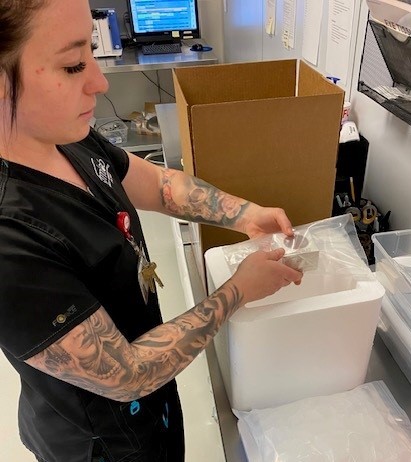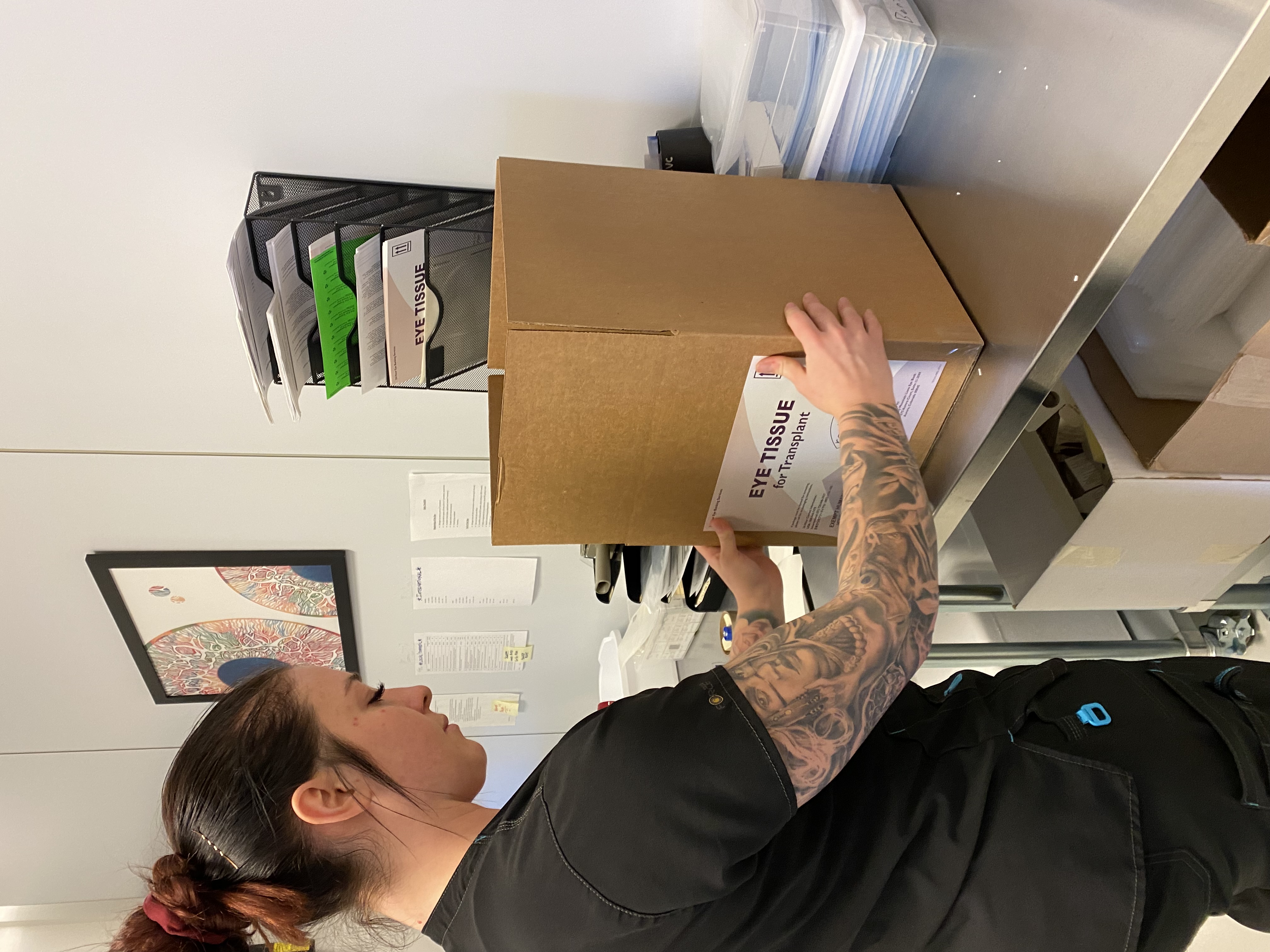A Day in the Life of a Distribution Coordinator: Meet Claire Mundt
Learn more about this unique career at the Rocky Mountain Lions Eye Bank
By Rae Price - February 21, 2024
Eye tissue distribution - the final step before going to surgeons.
There are many steps between corneal eye tissue recovery and getting it to the surgeon where it is transplanted in a recipient. The final touchpoint at Rocky Mountain Lions Eye Bank (RMLEB) is with the distribution team where tissue is matched to a surgeons’ request. Tissues are delivered locally or shipped for both domestic and international placement.
Claire Mundt is one of four distribution coordinators at RMLEB and has been with the organization for almost four years. She started with the organization as a tissue recovery technician, one of the people trained to recover eye tissue from donors.
The job requires strong attention to detail and deadlines, but no specific degree or prior education is required prior to training. Claire does have a degree in biology from Colorado Mesa University in Grand Junction, Colorado, which she noted probably helped her stand out from other job candidates. In addition, she said the biology knowledge has been helpful with knowing some medical and anatomy-related terminology.
RMLEB’s technicians recover eye tissue from deceased donors, then return it to the lab for evaluation, which includes looking at cell counts. Tissues are put in quarantine until serology reports are complete and the donor’s family has been contacted to answer health history questions about the donor. The safety and health of the cornea transplant recipient is of the utmost concern, which is why RMLEB screens eye tissue so thoroughly. Tissue that has passed all evaluations and quality control processes is “released” and ready to be distributed to surgeons.
Pieces of a puzzle.
Pairing corneas with recipients is where Claire’s job begins; she said it can be like putting a puzzle together since surgeons often have specific requests for the tissues they receive. “It’s just a puzzle, because one tissue might be good for a lot of things, but better for something else. My job is to pair the best suitable tissue for each individual surgery.
"The most challenging, at least for me is when we have a lot of tissue and a lot of different ways the pairing could go, then figuring out the best way to pair it. We always want to do the best by the donor,” she said.
After matching each cornea, Claire packages the eye tissue for shipping, and sometimes gets to personally make deliveries to local surgeons. However, she mostly coordinates shipping through overnight or commercial services.
Each eye tissue is stored in a corneal viewing chamber (CVC) with a special preservation liquid. It is then placed in a small, insulated cooler packed with “wet” ice, or ice that has started to melt. This maintains the tissue in the correct temperature range during transport. For tissues that are not local, the cooler is put in a box that identifies it as human eye tissue and it is ready to make its trip to the surgeon and cornea transplant recipient.

International shipping can sometimes be complicated, since each country requires specific paperwork. This is again where organization and attention to detail is helpful to know what is needed to have the eye tissue delivered on time. She noted while RMLEB ships a lot of tissues overseas, it can still be a challenge because of the logistics in booking flights and couriers from the airport to surgery centers.
Working with eye tissue donation.
For someone interested in working at the eye bank, Claire noted, “The job does involve dealing with death on a daily basis and not everyone can deal with that.” She reiterated the importance of being organized, saying, “You can’t procrastinate with this job because it is very time sensitive; no matter what role you are in here.” Recovered corneas are viable for transplant for up to 14 days, and most are transplanted within two to seven days. Having good communication skills is also vital to clearly understand surgeon requests and to be able to share information back to them, co-workers, and shipping companies.
The job is also rewarding, with different challenges every day. “It’s a different day every day, pretty much,” Claire said, “Some of it is routine but it’s never not interesting. You also have those days when it’s go-go-go, and the days go by really fast. You always need to be prepared for emergency calls that might come in.”
There is also room for growth in the job, “There is a lot of room for learning. I still don’t feel like I know everything; I don’t think I ever will,” said Claire. She added an opportunity for continued learning is getting to review donor charts, which aids in learning medical terminology and learning more about the cornea.
Claire’s colleagues in the community and professional relations department coordinate correspondence between cornea recipients and donor families, and often share these with the staff. Claire commented, “I always love seeing the letters from recipients and donor families. I think those help all of us stay on track, and they really remind us of our mission.”
Claire concluded, “It’s rewarding to be one of the final steps in helping to honor the donor’s decision.”
Learn more about careers with RMLEB


